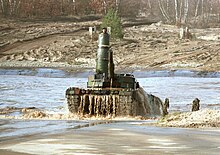Floating armor
Floating tanks or amphibians tanks are buoyant armored vehicles ; the spectrum ranges from light reconnaissance and armored personnel carriers to battle tanks .
development
As early as the First World War , there were attempts to give tanks amphibious capabilities. Since the tanks of that time proved too cumbersome, the experiments were not pursued further. In addition, a buoyant tank contradicted the operational doctrine of the time.
In 1931 Carden-Loyd Ltd. the first fully floatable prototype of a tankette, the AE 11. It was very light, had pontoons that ensured buoyancy and was driven by an additional screw . A whole series of vehicles should soon be built based on their model. Since the British government was not interested in the device, licenses were sold to the Soviet Union , among others . However, they were not interested in a simple replica of the tankette, but constructed a whole range of buoyant tanks for reconnaissance purposes, such as the T-37 and the T-40 . During the Second World War , these tanks proved to be inferior to the models of the German Wehrmacht . In order to save weight for buoyancy, these vehicles were consciously saved in terms of armor and armament.
The first attempts to make heavily armored vehicles floatable were made by the Americans and the British in advance of their landing in Normandy . The Americans already had light amphibious armored transport vehicles like the LVT , the British had the Terrapin Mk I , but the armor was too weak on both models. Therefore, one began with the modification of the M4 Sherman , which received swimming aprons made of canvas, which ensured the buoyancy. Two rear-mounted propellers served the propulsion. The result was called the DD tank . These vehicles turned out to be failures. Five of 32 tanks arrived at the hotly contested Omaha Beach . The remaining 27 floating tanks sank due to excessive waves.

In the post-war period, the floating tank concept was mainly pursued by the Warsaw Pact states . This is based primarily on the principles of operation for tanks of the Warsaw Pact . For this purpose, light tanks for air transport such as the PT-76 , the BMD series or the armored personnel carriers of the BMP series were developed on the Soviet side . All of these vehicles were buoyant. The aim was to cross bodies of water quickly and without great engineering effort in order to form bridgeheads. Compared to the WWII models, these tanks were heavily armed. They carried anti-tank missiles or could carry fully equipped groups of infantry .
Drive concepts
Propeller drive
This type of underwater propulsion was the first way to enable tanks to propel in the water. It was borrowed from shipbuilding. There are one or two propellers (screws) at the rear of the vehicle . When driving in water, the drive is switched and the gear shaft drives the propeller. In the beginning, the control was still carried out via a small rudder, but now the propellers are mostly used for the control.
Chain drive

The American LVT armored transport vehicle for amphibious operations was the first tank that was also propelled by its chain in the water. Originally, the vehicle was intended for civil use as an ambulance in the Everglades in Florida. The military variant was armored and armed. The drive with the chain in the water proved to be advantageous in several ways. On the one hand, the drive does not have to be changed and, on the other hand, the control does not change. The disadvantage, however, is that the vehicles are relatively slow in the water. Most vehicles with such a drive serve as landing craft or supply vehicles, while combat support vehicles based on the LVT were also developed in the course of the Second World War.
Water jet propulsion
The latest development of the drive is the water jet drive . Pumps suck in water, which is ejected backwards under high pressure and thus achieves propulsion. The drive works according to the recoil principle .
literature
- Philip Trewhitt: tanks. Neuer Kaiserverlag, Augsburg 2005, ISBN 3-7043-3197-X .
- Robert Jackson: tanks - models from around the world from 1915 to today. Parragon Books Ltd., Bath, UK, ISBN 978-1-4075-0670-8 .
- Christopher F. Foss , David Miller: Modern combat weapons. Stocker-Schmidt, Dietikon Switzerland, ISBN 3-7276-7092-4 .
- Roger Ford: tanks from 1916 to the present day. Karl Müller Verlag, Erlangen, ISBN 3-86070-676-4 .


